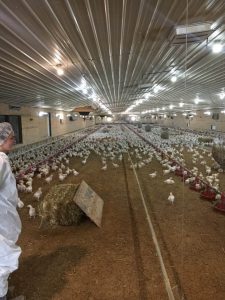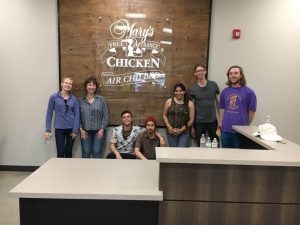Universities Seek Higher Welfare Poultry
Colleges and universities all over the country have begun leveraging their purchasing power to build more sustainable food systems. The 23-campus California State University (CSU) system has joined the Real Food Challenge, committing to sourcing 20 percent of their food from sustainable sources by 2020. The Real Food Challenge also includes a commitment to source meat, eggs, and dairy from farms that raise animals in higher-welfare conditions. Like other Real Food Challenge members, the CSU campuses have made progress toward their 20 percent commitment, but goals and commitments in the abstract are no match for a first-hand view of where our food comes from. For this reason, many campuses with questions about animal welfare and third party certifications are taking a closer look at more humane farms.
Last month, Farm Forward led a group of CSU food service directors, sustainability coordinators, students, and regional staff from Sodexo on a tour of Mary’s Chicken, a certified higher-welfare poultry operation in Fresno, CA. Mary’s is a family-owned company that raises Global Animal Partnership (GAP)-certified chickens and turkeys and operates a hatchery and processing plant.
The tour allowed dining directors and students to see three different farms that raise birds in progressively higher-welfare conditions. The first was a GAP Step 3 farm, which raises fast-growing Cornish Cross birds (42 days to market weight) in large barns where they are given natural light, seasonal access to the outdoors, and approximately 25 percent more space than birds raised on conventional farms. (By comparison, birds on conventional farms receive no natural light or outdoor access.)

Touring Mary’s Chicken facilities in Fresno, CA
Next up was a stop at a GAP Step 4 farm, which raises slower-growing birds (approximately 60 days to market weight) and provides year-round access to pasture. Even at first glance, the most obvious difference was the birds themselves—they looked healthier and were more active, perching on hay bales and foraging outside on the pasture.
The slower-growing birds on Mary’s Step 4 farms are genetically healthier than the Cornish Cross birds, who suffer because of their rapid growth. Today, fast-growing Cornish Cross birds are raised on 99 percent of all chicken farms in the U.S, but a major shift is underway in the chicken industry. Because of pressure from consumers and advocates, dozens of companies, including Compass Group, Aramark, and Sodexo, have committed to buy chicken that comes exclusively from slower-growing birds by 2024.
“This tour provided me with a lot of enlightening knowledge about higher welfare poultry farming and further encouraged my efforts to increase the amount of humane products served on our campus,” Rebecca Pope, student researcher for the Real Food Challenge at CSU Monterey Bay. “The benefits of sourcing products like Mary’s are worth the effort it takes to make them available and I hope that other CSU students continue to work to get more sustainable and just food options offered on their campuses.”
The day ended with a tour of Mary’s new slaughterhouse, which processes over 150,000 chickens each day. Particularly noteworthy is how Mary’s stuns the chickens before they are slaughtered. Most processing plants in the U.S. hang live birds upside down by their feet and stun them in electrified water baths. Mary’s is one of just a handful of plants nationwide that uses a multi-stage, controlled atmospheric system to stun birds. One of the major advantages of these systems is that conscious birds are not handled by employees. Controlled atmosphere stunning is widely accepted to improve welfare for chickens at slaughter, and although many companies, including Sodexo, have committed to using controlled atmosphere systems, it will likely be many years before the technology is widely used throughout the industry.
“The tour offered us a chance to see the way chickens can be raised. I think the tour motivated everyone to learn more about the chicken that’s served in the dining halls and find ways to incorporate higher-welfare options,” Rosie Linares-Diaz, the West Coast Coordinator for the Real Food Challenge. “What’s great is that more humane products are available on a scale that can meet the demands of the CSUs. I hope to see these kinds of products on all of the CSU campuses in the near future.”
Farm Forward organized the tour as part of our outreach for the Leadership Circle—a new program that helps universities, companies, and institutional buyers improve animal welfare in their supply chains. The Leadership Circle provides technical assistance, resources, and free consulting to institutions that commit to sourcing animal products from farms with a third-party animal welfare certification.

CSU campuses tour Mary’s Chicken in Fresno, CA
The Leadership Circle also encourages members to support farms that raise animals in the best possible conditions. When it comes to poultry, the highest-welfare farms raise heritage breed chickens and turkeys. Heritage birds grow at a normal rate, can thrive outdoors, and are the only turkeys that can reproduce naturally. As it happens, Mary’s is one of the few farms in the U.S. that raises GAP Step 5-certified heritage turkeys. Chefs and culinary professionals have long recognized heritage birds as the best tasting, and we hope to see them appear on university menus in the coming years.
Farm Forward staff looks forward to working with schools in the CSU system to help them source higher-welfare products and meet their Real Food Challenge goals.
To learn more about the Leadership Circle and Farm Forward’s work with universities and institutions, visit our website.